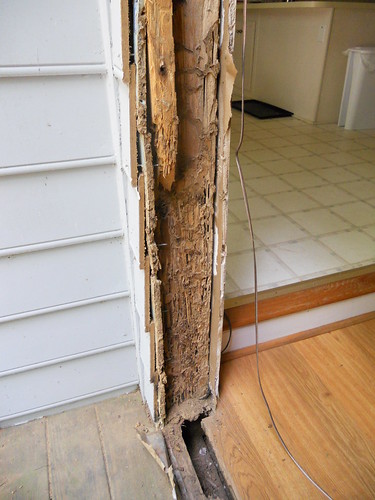 We’ve all seen them in the old cartoons. Cute little animated creatures with smiling faces and swirly antennae, that with a whirring sound and a cloud of speedy dust, eat an entire home from basement to attic, leaving nothing but the bricks from the chimney. But the real ones are far less cute, and, honestly, who cares if they’re smiling? They are resilient, can survive in basically any environment, are blind, and actually eat . . . . yes, EAT . . . consume . . . the wood your home is made of. There may be no cartoon whirring noise, and the roof might not fall down around you with seconds of their arrival, but the damage can be very palpable.
We’ve all seen them in the old cartoons. Cute little animated creatures with smiling faces and swirly antennae, that with a whirring sound and a cloud of speedy dust, eat an entire home from basement to attic, leaving nothing but the bricks from the chimney. But the real ones are far less cute, and, honestly, who cares if they’re smiling? They are resilient, can survive in basically any environment, are blind, and actually eat . . . . yes, EAT . . . consume . . . the wood your home is made of. There may be no cartoon whirring noise, and the roof might not fall down around you with seconds of their arrival, but the damage can be very palpable.
Termite infestations cause more than a billion dollars worth of damage every year in the United States. Since termites eat wood from the inside out, you can’t always tell just by looking at beams or floor joists whether or not you’ve got them in your home. But there are a number of ways to determine if they are there, eating your home silently from the inside out. And searching for them is a routine part of any home inspection.
Sometimes pencil-thin hollow mud tubes can be seen snaking up foundation walls . These tubes usually act as pathways from their nest to their feeding area, and as protection from the elements. Poking at suspected termite feeding grounds with a screwdriver can also bring you answers, but be sure you are prepared to face those answers when you are standing there with the screwdriver still in your hand. (Ick!). Believe it or not, some experts actually listen to beams and joists with a stethoscope to listen for the sounds of chewing termites. (Again, ick!) Of course, there is the less-recommended method of simply waiting for the wood damage to become evident and perhaps irreversible in your home.
Once you now you’ve got them, there are several ways to eliminate termites. By far, the most common method is injecting a termiticide, a slow-acting poison, into the ground around the house at intervals, to form a sort of barrier. The unsuspecting and unseeing termites walk through it, getting it on their bodies in the process. Then, when they go back to the nest and come into contact with other termites, the poison is passed around to unsuspecting family members, eventually wiping out the entire colony. Exterminators may also bury bait stations in holes dug around the house, with believe it or not, bits of wood as bait, to help in their monitoring of exactly where the feeding and nesting stations are. They can then inject the termiticide into bored holes more directly connected with feeding stations.
Unfortunately, termite exterminations are not exactly cheap. Depending on the type of treatment and the size of the property being treated, the cost can run from $1,000 to $2,000. Of course, it would probably cost even more than that to pay Grandma’s medical bills when she falls through the hole in the floor that the termites have eaten. So it’s all relative. Not to mention the fact that you are also buying peace of mind, and preventing feeling the heebie-jeebies every time you walk into your basement to do laundry, knowing you are not alone and are greatly outnumbered. It’s definitely NOT a problem to be ignored, but it’s also not insurmountable. Just remember – it’s YOUR house, and you are mightier than the termite!

 Site by Ha Media
Site by Ha Media
Leave a Reply